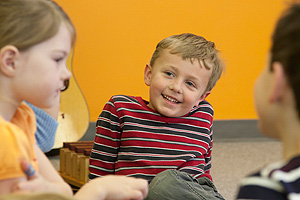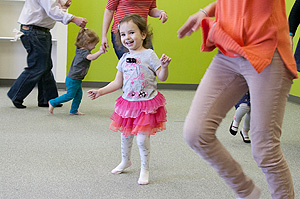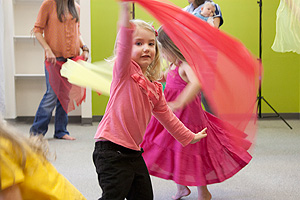The ideas set forth in this paper were presented by Dr. Suzanne Flynn, professor of linguistics, Massachusetts Institute of Technology, in a lecture given at the German International School Boston on May 4, 2006, and summarized by Anne Kern, parent of a first-grader at the school.
The Benefits of Bilingualism
Every child, wherever it grows up—from Botswana to Brazil, from Boston to Berlin—acquires its native language. We, as human beings, are richly wired for language, our brains are designed for it; indeed, we are language sponges. This is true for adults as well as children, though for many physio-, socio- and psychological reasons it is easiest for youngsters to jump headlong into the language pool.
If you are a parent who speaks a second language, do not hesitate to use it with your child—it would be a loss not to do so. A bilingual environment is an extraordinary gift, and there is no “teaching” involved. The only requirement is normal, everyday conversation. If you are not fluent in another language, you can still offer your child this wonderful opportunity through a bilingual education at school.
How do children learn language? What are the critical ingredients? The human brain is extraordinarily sensitive to language, and we are all linguistically capable without regard to intelligence or IQ. Human beings have an innate and infinite capacity for language. But in order to trigger this learning, there is one requirement, and that is a critical amount of directed input. Directed input means that children need to be talked to, and this speech must involve them directly. It does not matter which language is being spoken nor even what form the language takes—for example if it is visual, such as American Sign Language—so long as the child grows up in an environment where language is being used. Another factor in language acquisition is the quality of the input.
A first language cannot be learned through electronic means alone, such as television, computer or tapes, because this form of communication is not natural or interactive. In order for a child to deduce the properties of a language, all she or he really needs is to hear ordinary speech. The only other constraint on language learning is time, which children, luckily, have plenty of, though adults, alas, never seem to have enough.
The simultaneous acquisition of two or more languages is essentially the same as learning one first language. This is because, however many languages are being learned, the same brain mechanisms are always involved. Also, languages vary structurally only in finite ways, so once an underlying feature has been understood, it becomes easier to grasp this same feature in a different language. Although it seems like common sense to think that a child’s production of language would be delayed by dealing with more than one language at the same time, this, in actuality, is not the case. The onset of speaking will be in the same range as that of a monolingual child. In fact, multilingualism is a natural state of the mind. Traditionally, educators analyzed language learning according to the “dessert” model. In this view, there is only a finite amount of brain space available for language—the more you use, the more is used up, the way a delicious meal disappears around the dinner table. The “dessert” model holds that you have to “leave room” for learning, the way a mother would admonish her child to leave room for dessert. This way of thinking is erroneous. Language learning is not a pie, neither mincemeat nor apple, and no one needs to leave room for language by limiting themselves to just one. On the contrary, the more languages you learn, the easier it becomes to master even more.
There are many proven cognitive benefits to being bilingual, not to mention the social and cultural advantages gleaned from being able to speak and understand more than one tongue. For example, many studies have shown that bilingual children are ahead of monolingual children in their ability to abstract. This advantage expresses itself both in an enhanced ability to deal with mathematical concepts, as well as in the comprehension of metaphor and figurative speech. Another area positively affected by bilingualism is what is known as “executive function abilities,” which refer to the organization and processing of incoming speech. Children as well as adult language learners gain a tremendous benefit in their ability to focus. They are better able to block out extraneous “noise” and successfully deal with incoming information without getting distracted or derailed. In fact, there are currently studies underway to examine how language learning can help children with hyperactivity disorder be more focused. Of course, speaking more than one language has simple pragmatic and linguistic benefits as well, such as for travel, work, education, pleasure, and cultural sensitivity and exchange.
Finally, whether or not a person becomes truly bilingual, early exposure to another language carries with it lifetime linguistic benefits. In short, there are no deficits to multilingualism. Once a person or family has decided to place their feet squarely on the path to bilingualism, how best can they achieve their goal? What is the most effective way to learn a second (or third) language, and, once acquired, what can be done to retain it? The optimal method is a bilingual immersion program. If that option is not available, another important factor in determining success is to be taught subject matter in the target language. In other words, rather than learning German
as German—i.e. spelling, vocabulary, grammar and syntax—it is preferable to learn things in German: pottery, World Cup soccer, the diamond trade, yoga positions, map reading, opera singing, Hindu mythology, or just plain old academic subjects like music, art, math, literature and sports.But the easiest way of all to light the fuse of language learning is to create and sustain a
need for it. The greater the need, the faster the progress. Think back to the immense motivation of a small child wishing to be a part of the larger world around him. And imagine the vital need for communication of a recently arrived immigrant who must struggle in another country without the support of family or friends. In such situations, the need for learning the language is great, and the speed at which the task is accomplished (whether or not the new tongue is mastered in all its subtleties) is amazing.Any language that is not used consistently can begin to deteriorate. However, there are several ways of preventing this from happening. Parents and others can help maintain their children’s bilingualism by displaying and demonstrating a positive attitude. In some immigrant families or communities, first-generation children hesitate to use the native language of their parents. This can be counteracted by lending prestige both to the language and to the fact of being bilingual. The more prestige is associated with a language, the higher the self-esteem of the person speaking it. Another key method for maintaining fluency is to create a need, either where none, or no pressing one, exists. Perhaps there are monolingual grandparents or friends who come to visit from the country of origin. Or the family can participate in cultural, social or musical events where the other language is spoken. It is also a good idea to spend time in a country or region where the “second” language is the dominant one. This teaches a child that language is arbitrary—none is more important than another, the only difference is which one is spoken where—and with this realization, it makes sense to master as many as are needed.
In conclusion, do yourself, your family, neighbors and friends, a favor. Dare to learn another language, and if you won’t, give the gift of bilingualism to your child or another little one. They will enjoy it for a lifetime.







